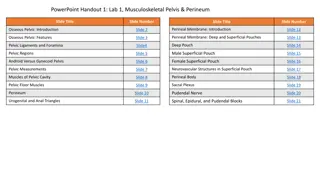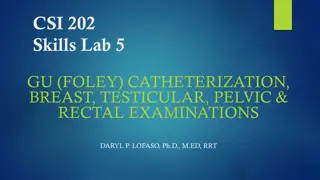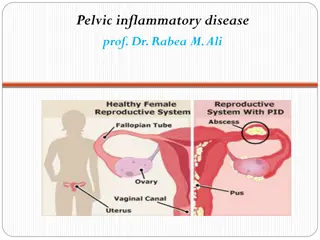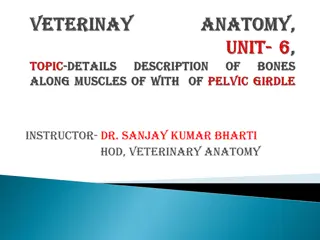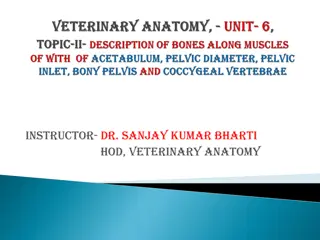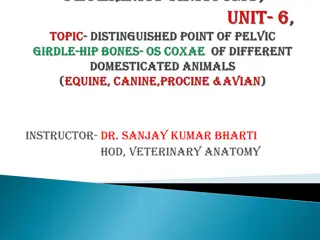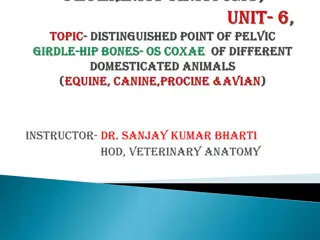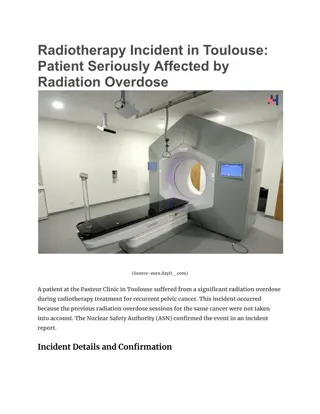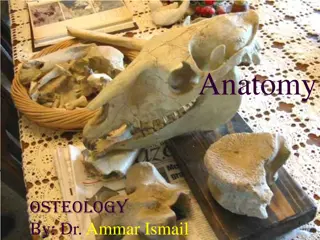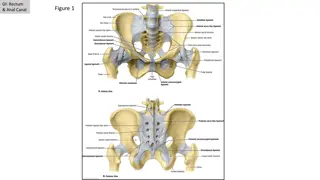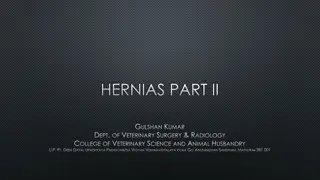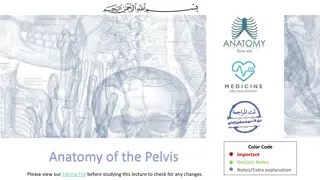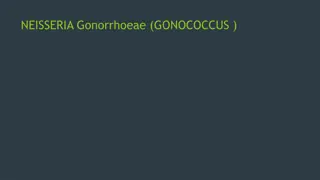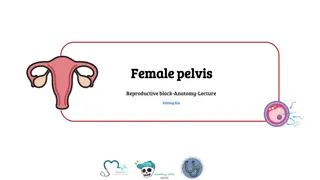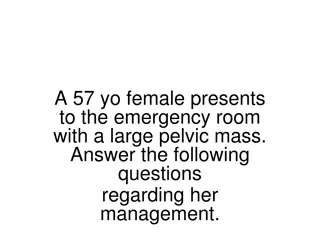Musculoskeletal Pelvis & Perineum Overview
Explore the anatomy of the pelvis and perineum, including the osseous pelvis structure, features, ligaments, and pelvic regions. Learn about the division of the abdominopelvic cavity and key neurovascular structures in this comprehensive PowerPoint presentation.
2 views • 21 slides
Pediatric Trauma Resources: Chest, Abdomen, and Pelvis Review
This guideline provides resources for the evaluation and management of chest, abdomen, and pelvic trauma in pediatric patients. It covers a range of topics including thoracic injuries, abdominal trauma evaluation, nonoperative management protocols, and guidelines for various pediatric injuries. The
5 views • 21 slides
How to Improve Fertility with Endometriosis
Endometriosis is a condition that affects around 11% of women of reproductive age, which can cause pelvic pain, heavy periods, and infertility. Endometriosis happens when the tissue that lines the uterus grows outside the uterus, leading to inflammation and the formation of scar tissue. Endometriosi
3 views • 8 slides
Anaerobic Bacterial Infections: Overview and Clinical Implications
Anaerobic bacterial infections are caused by bacteria that do not require oxygen for growth, posing challenges in diagnosis and treatment. This article delves into the types of anaerobic bacteria, their role in human infections, and common clinical presentations such as abscess formation. Gram-negat
2 views • 24 slides
Understanding Endometriosis: Symptoms and Causes
Endometriosis is a condition where endometrial tissue grows outside the uterus. Symptoms include pelvic pain, irregular periods, pain during intercourse, and difficulty getting pregnant. The exact cause is unknown, but theories point to genetics, immune system issues, and the spread of endometrial c
0 views • 6 slides
Veterinary Anatomy of Urinary System in Different Animals
The urinary system in animals includes kidneys, ureters, and the bladder, all crucial for filtration and urine excretion. The ureters are excretory ducts from the kidneys, while the bladder stores urine before expulsion. Various diagrammatic structures illustrate the urogenital system of animals, pa
0 views • 20 slides
Clinical Skills Lab: Foley Catheterization, Breast & Pelvic Examinations
This informative content covers topics such as urethral catheterization, indications for catheterization, anatomic landmarks, male and female catheterization techniques, nosocomial UTIs, pelvic and breast examinations, breast cancer screening recommendations, and breast cancer statistics. It is a co
1 views • 17 slides
Understanding Hypermobile Ehlers-Danlos, Mast Cell Activation, and Autonomic Dysfunction
Hereditary Connective Tissue Disorder, Hypermobile Ehlers-Danlos Syndrome (hEDS), and Mast Cell Activation Syndrome (MCAS) are three complex conditions with overlapping symptoms affecting collagen, joint laxity, and immune responses. Features associated with these conditions include joint pains, gas
2 views • 8 slides
Understanding Female Reproductive Infections and Inflammations
Female reproductive system infections such as Pelvic Inflammatory Disease (PID), Vaginitis, Cervicitis, Endometritis, and Salpingitis can lead to various symptoms and complications. These conditions are caused by different factors including infections, bacterial imbalances, and sexually transmitted
0 views • 44 slides
Understanding Pelvic Limb Anatomy: Bones and Muscles Overview
Bones and muscles of the pelvic limb, including the pelvis, thigh, leg, and foot, are detailed in this informative content. It covers the general designations of pelvic bones, descriptions of bones along with muscle attachments in various animals, and specifics about the hip bone structure and forma
1 views • 15 slides
Veterinary Anatomy Overview: Pelvic Cavity and Bony Pelvis Structures
The instructor, Dr. Sanjay Kumar Bharti, explains the acetabulum, obturator foramen, sexual differences, and characteristics of sheep and goats related to pelvic anatomy. Details include the structure of the acetabulum, the large obturator foramen, pelvic cavity, and differences between male and fem
2 views • 18 slides
Veterinary Anatomy: Pelvic Structures and Sexual Dimorphism in Animals
The article discusses the anatomy of the acetabulum, obturator foramen, pelvic cavity, pelvic inlet and outlet, and sexual differences in the pelvis, with a focus on sheep and goats. It covers the structure of these pelvic components and highlights the variations between male and female anatomies. D
0 views • 19 slides
Understanding Pelvic Anatomy in Veterinary Science
In this educational content, we delve into the intricate details of acetabulum, obturator foramen, pelvic cavity, pelvic inlet and outlet, sexual differences, and anatomical variations in sheep and goats. The explanations are accompanied by informative images to aid in better comprehension.
0 views • 19 slides
Patient Seriously Affected by Radiation Overdose
A patient at the Pasteur Clinic in Toulouse suffered from a significant radiation overdose during radiotherapy treatment for recurrent pelvic cancer.
0 views • 3 slides
Understanding Urinary Retention: Causes, Symptoms, and Management
Urinary retention can be acute or chronic, resulting in the painful inability to void or fully empty the bladder. In men, common causes include benign prostatic enlargement and post-surgery complications, while women may experience it due to pelvic prolapse or neurological issues. Initial management
3 views • 13 slides
Understanding Osteology: An Overview of Bone Structures and Skeleton Composition
Osteology is the study of anatomical structures such as bones, cartilages, and the skeleton that support and protect the body. It includes the classification of bones based on shape and function, details on bones of the thoracic and pelvic limbs, and the divisions of the skeleton into axial, appendi
0 views • 15 slides
Role of Lymphadenectomy in Genital Malignancies
Pelvic and paraaortic lymph node evaluation is crucial in the surgical staging of gynecological malignancies. The goals of lymph node dissection are to determine disease extent and guide further treatment. Pelvic lymph nodes include common iliac, external and internal iliac, obturator, sacral, and p
0 views • 16 slides
Insights on Pelvic Injuries, Open Fractures, and Young Classification in Trauma Care
Explore the expertise of Dr. Abdulaziz Alrabiah, MD in Emergency Medicine, Trauma & EMS through detailed images and descriptions of pelvic injuries, open fractures, and the Young Classification system. Enhance your knowledge on these critical aspects of trauma management.
0 views • 5 slides
Abdominal Examination in Pregnancy: Techniques and Objectives
Examination of the abdomen in pregnancy involves assessing various aspects such as determining gestational age, measuring symphysis-fundus height, evaluating fetal lie and presentation, checking liquor amount, listening to fetal heart sounds, and monitoring fetal movements. The process includes gene
0 views • 38 slides
Development of Prostatic Exosomal Protein Lateral Flow Chromatographic Strips for Chronic Prostatitis Detection
Chronic prostatitis/chronic pelvic pain syndrome (CP/CPPS) is a common urological condition with potential links to prostate cancer. Current diagnosis methods lack reliability, prompting the development of a novel point-of-care platform using prostatic exosomal protein as an indicator. This study fo
0 views • 20 slides
Understanding Pelvic Ultrasonography: A Comprehensive Guide
Explore the detailed anatomy and variations of the uterus, ovaries, fallopian tubes, and adnexa in pelvic ultrasonography. Learn about the different shapes and sizes of the uterus, layers of the uterine wall, and indications for pelvic ultrasound examination. Discover the significance of the appeara
1 views • 18 slides
Sex Determination Through Bone Analysis in Forensic Anthropology
In forensic anthropology, the pelvis and skull are crucial in sex determination, with additional assistance from femur, tibia, and humerus measurements. This data sheet guides on circling male or female based on traits like sub-pubic angle, pelvic cavity shape, eye orbit sharpness, zygomatic process
0 views • 33 slides
MRI Assessment Findings for Colon and Rectal Cancer
Baseline MRI assessment findings for colon and rectal cancer staging include detailed descriptions of the primary tumor, its borders, extent, muscularis propria involvement, lymph nodes assessment, vascular deposits, circumferential resection margin, peritoneal deposits, pelvic sidewall lymph nodes
0 views • 7 slides
Anatomy of GI Rectum and Anal Canal: A Detailed Visual Guide
This visual guide showcases detailed images of the gastrointestinal (GI) rectum and anal canal anatomy, including structures such as the perineum, pelvic diaphragm, external and internal anal sphincters, and various junctions within the rectum. Each image provides a clear depiction of the anatomical
0 views • 6 slides
Physiotherapy Support for Mothers with OASI - Expert Guidance and Rehabilitation
Providing specialized physiotherapy support for mothers experiencing Obstetric Anal Sphincter Injuries (OASI) is crucial for addressing immediate problems like pain, urinary or fecal incontinence, and more. With a focus on pelvic health, this approach involves reassurance, tailored pelvic floor musc
0 views • 12 slides
Understanding Perineal Hernias in Veterinary Surgery
Perineal hernias are a common condition in uncastrated males but can also occur in females and cats. Weakness in the pelvic diaphragm can lead to herniation due to factors like hormonal disorders, prostatic diseases, and rectal issues. The symptoms include swelling in the perineal region, and diagno
0 views • 25 slides
Understanding Pelvic Anatomy: Bones, Joints, and Muscles
Explore the comprehensive overview of the anatomy of the pelvis, including its walls, bones, joints, muscles, and differentiations between male and female pelves. Learn about the boundaries, subdivisions, and pelvic floor components, as well as the arterial, nerve, lymph, and venous supplies. Delve
0 views • 27 slides
Understanding the Anatomy of the Ureter: A Comprehensive Overview
The ureter is an important structure responsible for transporting urine from the kidney to the bladder. This article delves into the measurements, course in the abdominal and pelvic regions, parts and relations of the ureter. Detailed descriptions and images provide a clear understanding of this vit
0 views • 16 slides
Understanding Occipito-Posterior Position of the Fetal Head
Occipito-posterior position of the fetal head occurs when the head is in one of the oblique diameters with the occiput directed posteriorly. It can be categorized into Right Occipito-Posterior Position (ROP) and Left Occipito-Posterior Position (LOP), affecting 13% of vertex presentations. Causes in
0 views • 32 slides
Understanding Occipito-Posterior Position of the Fetal Head
Occipito-posterior position refers to the fetal head being directed towards the back of the pelvis. This positioning can occur to the right (ROP) or left (LOP) side. It occurs in 13% of vertex presentations and may be caused by factors like pendulous abdomen, pelvic brim shape, or sacral alignment.
0 views • 31 slides
Understanding Chlamydia and Syphilis: Common STDs to Know
Chlamydia and syphilis are common sexually transmitted infections that can have serious health consequences if left untreated. Chlamydia is often asymptomatic but can lead to complications like pelvic inflammatory disease in women. Syphilis presents with painless sores and can progress to affect the
0 views • 20 slides
Screening Visit Procedures for MTN-028 Study
The MTN-028 study involves comprehensive screening visit procedures, including administrative, counseling, clinical, and laboratory considerations. Elements such as physical exams, HIV testing, pelvic exams, laboratory tests, and informed consent are detailed. Tools for informed consent, long-term s
0 views • 41 slides
Clinical Manifestations and Complications of Neisseria Gonorrhoeae Infection
Neisseria gonorrhoeae, also known as gonococcus, is a bacterial pathogen responsible for gonorrhea. The virulence factors of N. gonorrhoeae include pili/fimbriae for adhesion, outer membrane proteins like Porin for protection, opacity-associated protein for adhesion to neutrophils, and more. Clinica
0 views • 15 slides
Gynecological Surgical Complications and Treatment Overview
This content covers complications in gynecological surgery, historical perspectives on prolapse and incontinence surgery, treatment methods like weight reduction, pelvic floor training, medication, injections, and surgeries like Burchplasty and Tension-free Vaginal Tape (TVT). It also discusses a mu
0 views • 27 slides
Understanding Female Pelvis Anatomy and Differences from Male Pelvis
The female pelvis anatomy lecture covers the pelvic wall, bones, joints, and muscles. It explains the boundaries, subdivisions, and types of female pelvis, along with details on pelvic walls, floor, and diaphragm components. Additionally, it includes information on arterial, nerve, lymph, and venous
0 views • 13 slides
Management of a 57-Year-Old Female with a Pelvic Mass: Assessments and Work-up
A 57-year-old female presents to the emergency room with a large pelvic mass. Detailed history and physical examination are crucial, focusing on risk factors, past medical history, family history, medications, habits, and social factors. Along with vital signs and lymphadenopathy evaluation, a thoro
0 views • 23 slides
Protein Secondary Structure Prediction: Insights and Methods
Accurate prediction of protein secondary structure is crucial for understanding tertiary structure, predicting protein function, and classification. This prediction involves identifying key elements like alpha helices, beta sheets, turns, and loops. Various methods such as manual assignment by cryst
0 views • 30 slides
Understanding the Hierarchy of Protein Structure
To understand proteins' final shape and function, one must grasp the primary, secondary, tertiary, and quaternary structure levels. Proteins, composed of amino acids, fold into various shapes crucial for their roles such as signaling, catalysis, and structure. The primary structure represents the am
0 views • 28 slides
Understanding Pelvic Floor Dysfunction and Prolapse in Women
Pelvic floor dysfunction and prolapse are common issues affecting women, impacting their physical and emotional well-being. Surgical treatment may be necessary for symptomatic cases, but a thorough evaluation of symptoms, obstetric history, and other factors is crucial. Addressing precipitating fact
0 views • 72 slides
Understanding Urogynaecology: A Comprehensive Overview
Urogynaecology is a subspecialty of Gynaecology that focuses on female lower urinary tract and genital tract issues. This field has evolved significantly with the introduction of Urodynamics in 1970, leading to better diagnoses and management of conditions like urinary incontinence and pelvic organ
0 views • 31 slides
